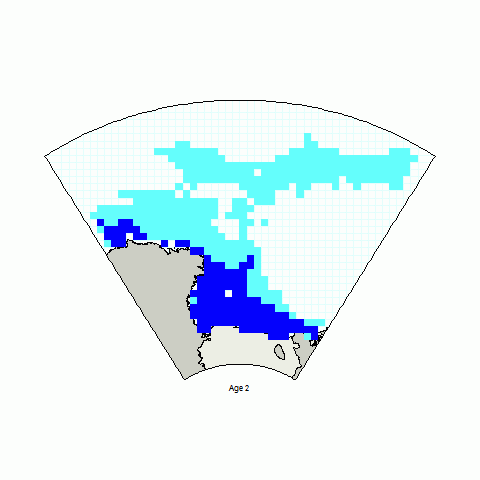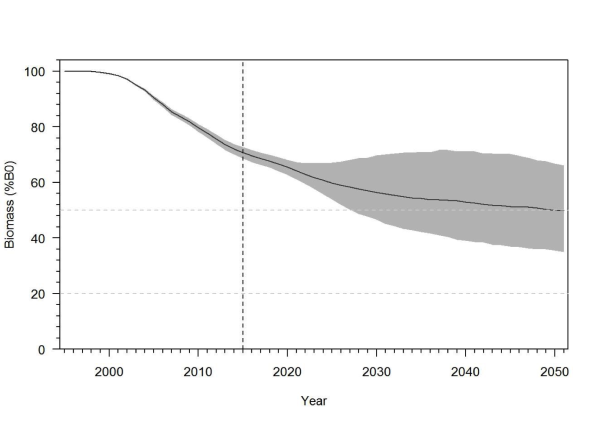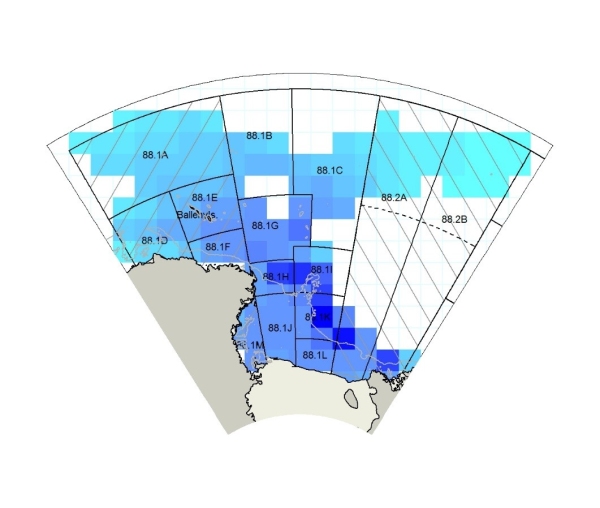The Commission for the Conservation of Antarctic Marine Living Resources (CCAMLR) uses two criteria to set the annual catch limit:
- the biomass of the spawning stock must be at or above 50% of its unfished level in 35 years time.
- the risk of the spawning biomass of the stock falling below 20% at any time in the next 35 years must be less than 10%.
These criteria are applied using a stock assessment model. The model involves estimating the number of fish in the stock, and the level of fishing that would satisfy the criteria above. The stock assessment requires knowledge about the spatial extent of the stock, the growth and reproductive characteristics of Antarctic toothfish, and a relative abundance index for the population.
Stock assessments of Antarctic toothfish in the Ross Sea region have been carried out since 2005. See details of the Antarctic toothfish stock assessment model [PDF 2.1 MB]
The stock assessment model
A stock assessment model was first developed for Antarctic toothfish in the Ross Sea region in 2005 and has been improved and updated biennially since then. See A stock assessment model of AntarctIc toothfish (Dissostichus mawsoni) in the Ross Sea region incorporating multi-year mark-recapture data - Mormede et al. 2014 [PDF 2.1 MB].
The model has the following characteristics:
Model structure
- Fully Bayesian age-structured model.
- Two-sex, ages 1–50+, single area.
- Model years from 1995 to 2015 (catch starts in 1998).
- Tagging data by year of release and year of recapture.
- Assumes initial biomass is at an equilibrium state.
- Has 2 main time steps: summer (fishing) and winter (spawning).
- Has 3 fisheries defined (Shelf, Slope, and North).
Observations to inform the model
- Commercial catch data: 1997-2015.
- Tag-recapture data: 2001-2015.
- Age frequency data: 1997-2015.
- Recruitment surveys: 2012-2015.
The model uses data about released and recaptured fish over many years, as well as the age distribution of the catch in each year, along with other information on the biology and amount of catch. The model also estimates fishing selectivities for the three fishery areas as well as strengths of annual recruitment since 2003. The current estimate of the initial biomass of the spawning stock was 68,790 tonnes. The estimated biomass in 2015 was estimated as 70% of the initial value.
For more information on the most recent stock assessment of Antarctic toothfish, see the CCAMLR Subarea 88.1 Fishery Reports.
Spatially explicit operating model
Spatial population models were developed to capture the distribution of toothfish in the Ross Sea region and its spatial population dynamics.

Spatial population models were developed to capture the distribution of toothfish in the Ross Sea region and its spatial population dynamics. Simulations suggest that the current single-area stock assessment (which ignores spatial variation in stock structure) is likely underestimating the true biomass; by 19–43%. These spatial models have also been used to investigate the impact of different management actions to open or close some areas to fishing.
For more information on the spatially explicit operating model see the journal paper Mormede et al, Stock assessment model of Antarctic toothfish (Dissostichus mawsoni) in the Ross Sea region incorporating multi-year mark-recapture data, CCAMLR Science, 2014. [PDF 2.2 MB]


